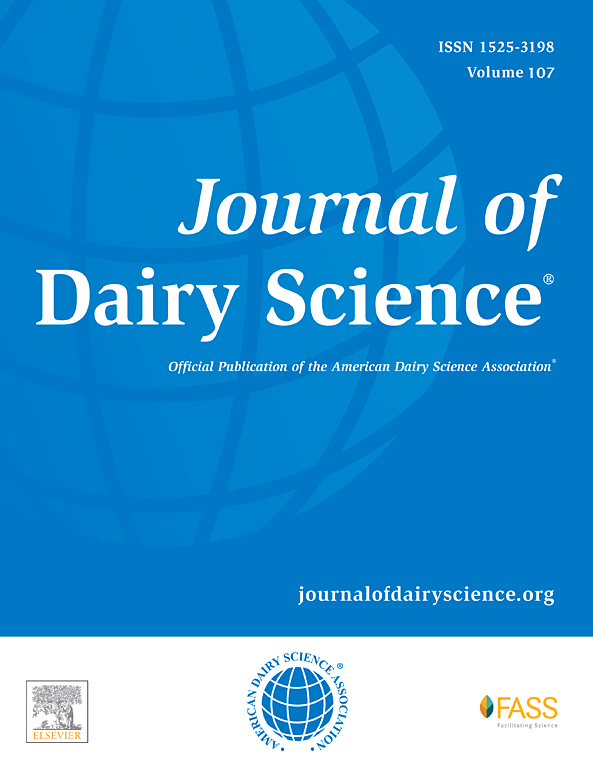一项观察性研究调查乳头状况与临床乳腺炎风险的关系。
摘要
目的是研究机器挤奶诱导的奶牛乳腺组织变化与荷斯坦奶牛临床乳腺炎发生之间的关系。我们在纽约州的一家商业奶牛场进行了两项独立的前瞻性队列研究,以研究机器挤奶引起的短期变化(试验1)和机器挤奶引起的长期变化(试验2)与临床乳腺炎发生的关系。每个试验包括4个3周的阶段。在每个周期的第1天,通过目测和手触诊评估STC和LTC。根据乳头变色、乳头基部状况和乳头末端的一致性评估短期乳头组织变化,并将其分类为二元变量(STC存在或不存在)。长期的乳腺组织变化分为4组:无老茧(评分1),没有或只有轻微粗糙的老茧环(评分2);角蛋白叶从小孔延伸1 - 3mm,存在糙皮环和粗糙(得分3);角质环,角蛋白叶过多,距口≥4mm(评分4)。从畜群管理软件中提取临床乳腺炎发生的数据。我们在每个3周的试验期中使用四分之一的首次临床乳腺炎事件,并在两个试验期之间的一个季度内使用14天的间隔来定义新的乳腺炎病例。在试验1中,66,702例患者中有6,110例(9.2%)在4个3周的时间内被记录为STC。试验2中LTC的频率分布如下:61,624例患者中有7,348例(11.9%)为1分,48,553例(78.8%)为2分,5,514例(8.9%)为3分,209例(0.3%)为4分。我们在试验1中记录了944/66,702例(1.4%)临床乳腺炎病例,在试验2中记录了866/61,624例(1.4%)病例。采用logit链接和二项分布的广义线性混合模型来检验机器挤奶引起的乳腺组织变化是否与临床乳腺炎的发生有关。在试验1中,我们分析了来自5094头奶牛的66702个四分之一水平的观察结果。我们发现STC与临床乳腺炎的发生没有明显的联系。与四分之一没有STC的乳头相比,临床乳腺炎的赔率(95% CI)为1.22(0.95-1.59)。在试验2中,我们使用了4,998头奶牛的61,624个四分之一水平的观察结果。我们发现LTC和临床乳腺炎的发生没有明显的联系。与1分之一乳头端部光滑的患者相比,2分的乳腺炎发生率为1.02(0.77-1.36),3分的乳腺炎发生率为1.19(0.84-1.69),4分的乳腺炎发生率为2.14(0.80-5.71)。我们的结论是,在这里提出的研究队列中,机器挤奶引起的乳头组织改变与临床乳腺炎的发生无关。The objectives were to investigate the association between machine milking-induced teat tissue changes and the occurrence of clinical mastitis in Holstein dairy cows. We conducted 2 separate prospective cohort studies at 1 commercial dairy farm in New York State to study the association of machine milking-induced short-term changes (STC, trial 1) and machine milking-induced long-term changes (LTC, trial 2) with clinical mastitis occurrence. Each trial consisted of four 3-wk periods. On d 1 of each period, STC and LTC were assessed through visual inspection and manual palpation. Short-term teat tissue changes were assessed based on teat discoloration, the condition of the teat base, and the consistency of the teat end and categorized into a binary variable (STC present or absent). Long-term teat tissue changes were categorized into 4 groups as follows: no callosity present (score 1), callosity ring present with no or only mild roughness (score 2); callosity ring and roughness present with keratin fronds extending 1 to 3 mm from the teat orifice (score 3); and callosity ring present with excessive keratin fronds extending ≥4 mm from the teat orifice (score 4). Data on clinical mastitis occurrence was extracted from the herd management software. We used the first clinical mastitis event of a quarter for each 3-wk trial period and applied a 14-d gap to define a new mastitis case within a quarter between 2 trial periods. In trial 1, STC was documented in 6,110 of 66,702 cases (9.2%) over the four 3-wk periods, The frequency distribution of LTC in trial 2 was as follows: score 1 in 7,348 of 61,624 cases (11.9%), score 2 in 48,553 cases (78.8%), score 3 in 5,514 cases (8.9%), and score 4 in 209 cases (0.3%). We documented 944/66,702 (1.4%) clinical mastitis cases at the quarter level during trial 1 and 866/61,624 (1.4%) cases during trial 2. Generalized linear mixed models with a logit link and a binomial distribution were used to test if machine milking-induced teat tissue changes were associated with clinical mastitis occurrence. In trial 1, we analyzed 66,702 quarter-level observations from 5,094 cows. We found no significant association between STC and clinical mastitis occurrence. Compared with a quarter with a teat without STC, the odds (95% CI) of clinical mastitis were 1.22 (0.95-1.59). In trial 2, we used 61,624 quarter-level observations from 4,998 cows. We found no significant association between LTC and clinical mastitis occurrence. Compared with a quarter with a teat with a smooth end (score 1), the odds of a clinical mastitis case were 1.02 (0.77-1.36) for score 2, 1.19 (0.84-1.69) for score 3, and 2.14 (0.80-5.71) for score 4. We concluded that in the study cohort presented here, machine milking-induced teat tissue changes were not associated with the occurrence of clinical mastitis.

 求助内容:
求助内容: 应助结果提醒方式:
应助结果提醒方式:


